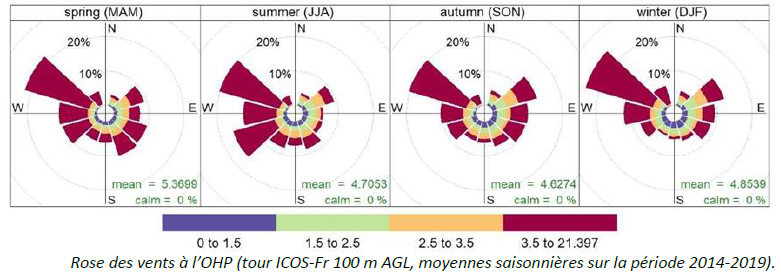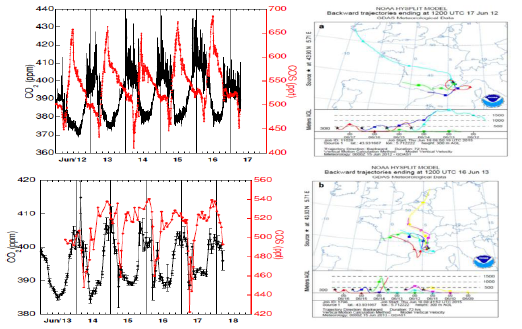PAGE UNDER CONSTRUCTION…
Summer is characterized by episodes of upwelling sail breezes.
OhP is a rural site, with sometimes arrivals of contaminated air masses
by anthropogenic activities at the local level (Durance Valley),
(Rhône Valley, Metropolis of Aix-Marseille) and Synoptic (France, Europe,
synoptic/global – e.g. Canadian fires, volcanic eruptions, etc.). Local scales
more about the atmospheric boundary layer, while the scale of the
synoptic/global concerns the troposphere as a whole and the stratosphere.

three main research themes:
Thematic 1
-
-
- Balances and dynamics of trace gases in the atmospheric boundary layer and the lower troposphere
-
Site interests and progress:
The OHP is located in rural areas of the PACA region, characterized by a warm and sunny climate conducive to high emissions of biogenic volatile organic compounds (COVB), compounds involved in the reactivity of radical OH, in the production of ozone or secondary organic aerosol (OSA), which itself has an uncertain impact on the Earth’s radiative balance, atmospheric chemistry, ecosystems and health. Vegetation activity and variability are the main factor controlling the concentration of local atmospheric CO2 at daytime to seasonal scales. The OHP is also located a few dozen kilometres from the metropolis of Aix-Marseille and the Rhone Valley, two areas that emit high greenhouse gases, gas pollutants such as ozone. OHP is under the influence of continental or marine air masses that can bring plumes from more or less distant, anthropogenic or natural sources/wells. With regard to these different fields of scientific study, uncertainties remain wide, especially in the current context of climate change, which requires long-term monitoring of the evolution of these observables and associated processes. The observations available at the OHP (including INSU-labelled measures and non-INSU measures such as those of the O3HP), and those planned for the medium term at the OHP and the site’s capacity to host campaigns, allow us to develop work on greenhouse gases, the carbon cycle, COVbCs, the oxidizing capacity of the atmosphere or ground-level ozone, including through:
The study of local sources/wells vs. the advection of plumes at the OHP:
o OCS and CO2: ANR CANOPEE Project (Belviso et al, 2016)
o Ground-level ozone: A. Gaudel’s thesis on the O3 (Gaudel, 2016; Gaudel et al, 2016)
o VOC: Project MEDEE/thesis R. Baghi (Baghi, 2013; Baghi et al, 2012).
The study of emission factors and associated processes:
o COVB: ANR CANOPEE Project (Kalogris, 2016; Kalogridis et al, 2016; Kalogridis et al, 2014);
o Isoprene: PROJECT CHARMEX/thesis A. Genard-Zielinski (Genard, 2015; Genard-Zielinski et al, 2018);
o Reactivity OH and COVB: ANR CANOPEE/thesis N.Zannoni Project (Zannoni, 2015; Zannoni et al, 2016);
The OHP as a groundground for the study of regional balance sheets:
o CO2: OT-MED AMC Project (Xueref-Remy et al, 2017; Xueref-Remy et al, 2018; M2 internship by Mr. Milne: Mine, 2018; Milne et al, in prep; B. Nathan’s postdoctoral fellowship: Nathan et al, in prep).
Highlights (2012-2019):
- Co2 study in the CLA:
- Study of aerosols in the troposphere
- Process and training
- Characterization of sources
- Transportation and dynamics
- Spatialization of ground-to-space observations
- Representativeness
- Model setting
- Satellite validations

The OT-MED AMC project (2016-2020) – IMBE, LSCE, MIO Figure 4. OhP as a continental melting site for CO2 at the regional level and the impact of urban emissions on CO2 in Marseille (study on 2014-2018; Milne et al, in prep). One of the recent themes of the OSU Pytheas, started in 2016 (HCERES 2017), is the understanding of the CO2 balance in the PACA region through the atmospheric approach. According to existing emissions inventories, urbanised and industrialized regions now account for more than 70% of global fossil CO2 emissions. These are key areas for action on climate change. However, uncertainties about these emissions are very high In the OT-MED AMC project (2016-2019), we are developing an atmospheric approach to verify AtmoSud’s emissions inventory. OHP weather measurements ICOS-Fr and NDACC-Fr, atmospheric CO2 and CO measurements measured at OHP by SNO ICOS-FR, as well as atmospheric boundary layer heights (hCLA) extracted from Data from LIDAR ICOS-Fr and NDACC-Fr radiosurveys, allow us to characterize the composition of the background atmosphere and the dynamics of the CLA at the OHP, upstream of the metropolis of Aix-Marseille. The OHP is now integrated into a regional CO2 network including a station in the heart of Marseille (Fig.4) that allows to deduce the urban CO2 plume (a few ppm to more than 100 ppm), and also to model it (WRF-CHEM and MESO-NH models). This work has been the subject of 2 conferences (Xueref-Remy et al, 2017; Xueref-Remy et al, 2018) and 2 articles in preparation (Milne et al, 2019; Nathan et al, 2019). In addition, the urban CO2 plume could have an impact on air-sea flows in the Bay of Marseille. This question is addressed in collaboration with the MIO (OT-MED AMC project) and is the subject of two articles in preparation, both using IN particular the ICOS-Fr data of the OHP (Wimart-Rousseau et al, in prep; Lajaunie et al, in prep). OHP data can be accessed through the ICOS databases and via the AERIS databases for Lidar ICOS and NDACC data.
-
SCO study in the CLA: The CANOPEE project (2011-2015) – LSCE, IMBE, INERIS, LCE, LISA:

SCO (Carbon Oxysulfide) is a compound absorbed by vegetation during the photosynthesis process. Plants assimilate both SCO and CO2, and since there is no mechanism equivalent to CO2 respiration for SCO, the absorption of SCO by plants would be directly proportional to their photosynthetic activity. The SCO has been studied for a few years to estimate its ability to calculate the amount of CO2 absorbed by vegetation by photosynthesis. During the campaigns of the ANR CANOPEE project at the OHP (Fig. 6), it was shown: (1) in June 2012, a very good correlation between CO2 and COS in low winds and at dawn, before the development of the CLA; (2) in June 2013, the contribution of COS via the oxidation of C2S emitted by the textile industry from the Rhone Valley and transported in the CLA to the OHP. These results show the potential of COS as a tracer of photosynthesis, subject to selecting favourable weather and day times (Belviso et al, 2016). Questions remain to be elucidated on the role of soils in sCO daytime to seasonal variability. Data from these campaigns are available in the CNRS archives (https://mycore.core-cloud.net/public.php?service=files&t 04c566376fa82e5ebdf09cd18630d (Belviso et al., 2016).
Thematic 2
Thematic 3
- Balances and dynamics of trace gases in the atmospheric boundary layer and the lower troposphere
-
